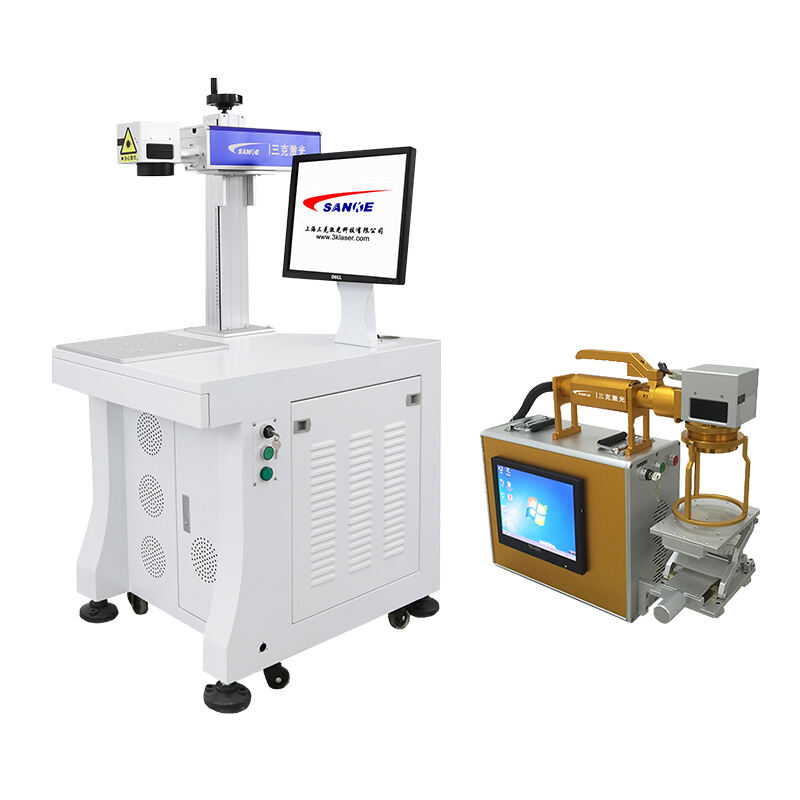مقدمة
إن الحاجة إلى آلة الحفر بالليزر هي أمر لا ينبغي تجاهله، وسواء كنت في المنتجات المعدنية أو المنتجات البلاستيكية، فإن هذه الورقة هي مجرد مثال للعناصر الرئيسية التي يجب مراعاتها عند اختيار آلة الحفر بالليزر لتطبيقك الفريد.
أصبحت أجهزة الحفر بالليزر بمختلف الأشكال متاحة الآن
كل منها لديه مجموعة خاصة من الخصائص وبالتالي يمكن استخدامها في أماكن مختلفة. يتم تقديمها كما يلي:
أ. الليزر الصلب: بفضل وقت تشغيلهم الطويل، الجاذبية البصرية والصديقية للبيئة، تُستخدم هذه الأجهزة في مجموعة متنوعة من التطبيقات.
B. ليزر CO2: يمكن استخدام هذه الليزرات للقص وللحفر، ولها تأثيرات جيدة بشكل خاص على المواد غير المعدنية.
C. ليزر الألياف: بفضل دمج القوة العالية والدقة، تعتبر ليزر الألياف مثالية لحفر ثقوب دقيقة ودقيقة في المعادن وغيرها من المواد الصلبة.
D. ليزر الإكسيمر: مع فترات نبضات قصيرة للغاية، فإن ليزر الإكسيمر مناسب تمامًا لحفر ثقوب ذات نسبة عمق إلى قطر كبير وعملية المواد الحساسة.
E. المقارنة: اختيار نوع الليزر يعتمد على المادة التي يتم حفرها وكذلك المتطلبات الخاصة لتطبيقك.
توافق المواد
عند اختيار عملية الحفر بالليزر، من المهم مراعاة المواد التي سيتم استخدامها.
المعادن: من الصعب حفر المعادن باستخدام مؤشر الليزر ذو صورة التشتت المتماسكة (CDI). بعد كل شيء، لا تنعكس أشعة الضوء بسهولة من كتلة الحديد. ومع ذلك، باستخدام ليزر الألياف، لن يكون هناك أي مشكلة. فإن كثافة طاقتهم العالية مصممة خصيصًا للتعامل مع مثل هذه الحالات.
من أجل التعامل
كميات كبيرة من الضرر في جملة قصيرة جداً. ما لا ت擅长 به ألياف الليزر هو تقشير قطع العمل المعدنية وأدوات الصقل المقابلة عن السطح الموزع.
البلاستيك: يمكن استخدام ليزر CO2 لحفر البلاستيك الصلب PVC ذو مؤشر الذوبان المنخفض والبلاستيك الهندسي العالي دون التسبب في الكثير من الحرارة أو الشقوق.
الخطوط أو الحروق. هناك إمكانية أخرى لهذه الطريقة وهي قطع ثقوب في مكابس محرك السيارة البلاستيكية بالكامل التي تم استبدالها حديثًا والتي تم فصلها عن أغلفتها الأسطوانية
السيراميك: لحفر السيراميك يتطلب ليزرًا صلبًا أو ليزر إكسيمر يمكنه التعامل مع صلابة المادة.
المposites: بدون تحلل الطبقات، يجب أن يكون لدى آلة الحفر القدرة على العمل مع الهياكل المعقدة للمواد المركبة.
المواد شبه الموصلة: تحتاج إلى تحكم دقيق لتجنب إلحاق الأذى بالمادة الحساسة.
دقة وتسامح الحفر
يتطلب الحفر بالليزر الدقة أكثر من أي شيء آخر، وللوفاء بنفس المعايير التي تريدها في آلة:
أ. إذا كان سيتم إنشاء الثقوب فقط، فإن هذه الدقة تكون أعلى.
ب. هذا هو السبب في أن التوحيد مهم جدًا: يجب أن يلبي كل ثقب معيارًا دقيقًا بغض النظر عن مكانه على لوحة المشروع أو(substrate) التي يوجد عليها.
ج. قارن إمكانيات الآلة مع متطلبات تطبيقك والمتطلبات العالية الدقة.
الف. حجم الإنتاج وسرعة الحفر
إن حجم الإنتاج وسرعة الحفر هما عاملان رئيسيان في اختيار الآلة:
أ. قد يكون من الضروري تحقيق معدل إنتاج أعلى للحفاظ على معدلات إنتاج كافية أثناء العمليات ذات الحجم الكبير.
ب. يمكن أن تتأثر الإنتاجية العامة بسرعة الحفر. لذلك، يجب أن تختار آلة قادرة على meeting احتياجات الإنتاج المطلوبة مع تقديم جودة عالية.
ج. بالنسبة للآلات، قم بمراجعة المواصفات وتأكد من أنها تلبي احتياجات إنتاجك.
س. حجم الآلة ومنطقة العمل
إن الحجم الفعلي لآلة الحفر بالليزر دائمًا محل اعتبار عملي. كما يندرج حجم مساحة العمل المطلوبة ضمن هذا الموضوع.
أ. يجب أن تكون الآلة ملائمة لمساحتك وعلى أرضية الإنتاج
ب. تذكر أن حجم peace العمل يؤثر، وفكر فيما إذا كانت الآلة ستتعامل براحة معه.
ج. اترك مساحة كافية في حالة الحاجة إلى معدات铺iliary وإجراءات السلامة.
سابعاً. التكلفة
عند شراء معدات آلات جديدة، فإن التكلفة دائمًا عامل حاسم:
أ. بناءً على طاقة الآلة ووظائفها، قد تتباين تكاليف الاستثمار الأولي بشكل واسع.
ب. يجب اعتبار تكاليف التشغيل، بما في ذلك الطاقة اللازمة للآلة والصيانة، جزءًا من التكلفة الإجمالية للملكية.
ج. فكر في العائد المحتمل على الاستثمار (ROI) والتوفير في التكاليف الذي قد تجلبه الآلات.
ثامناً. ميزات السلامة واللوائح
السلامة دائمًا هي الأولوية. عند العمل مع تقنية الليزر:
أ. تأكد من أن الآلة تتوافق مع فئات السلامة والمعايير الصناعية للليزر.
ب. إذا لم تكن الآلة آمنة للتشغيل، فيجب أن تحتوي على ميزات السلامة المتأصلة مثل الأقفال التفاعلية التي تمنع حدوث تشغيل عرضي أو أزرار الطوارئ التي ستعطل الكهرباء فوراً إذا حدث خطأ، بالإضافة إلى أغطية العودة إلى مكانها بمجرد فتحها بعد الاستخدام.
ج. يجب احترام القواعد واللوائح من أجل حماية عمالك وإنشاء بيئة عمل آمنة.
IX. سهولة التشغيل والصيانة
متطلبات قابلية استخدام الماكينة وصيانتها للحفاظ على استمراريتها: هذا ما يحافظ على استمرار عمل مؤسستك على أساس يومي.
أ. سيوفر المشغل الكثير من الوقت إذا تم استخدام واجهة المشغل والتحكم السهل.
ب. بناءً على ما يمكن لشركتك القيام به داخليًا (أو عبر عقود الخدمة)، يجب أن تكون متطلبات الصيانة قابلة للإدارة.
ج. قد يحتاج المشغلون وفريق الصيانة إلى تدريب؛ راعوا إذا كان هناك أي مكان للحصول على التدريب.
X. الدعم الفني والخدمة
لا يمكن المبالغة في أهمية وصول العميل إلى الدعم الفني والخدمات من الشركة المصنعة. اختر شركة مصنعة معروفة بخدمة العملاء الجيدة والخدمة بعد البيع. توفر عقود الصيانة الراحة والوقت التوقف الأقل. فكر في مدى سرعة استجابة شركتك المصنعة أو قدرتها على حل المشكلات بشكل فعال. تم العثور على أن الوقت الذي يستغرقه إكمال فتحات التهوية يُقلص بشكل كبير إذا تم استخدام ماكينات الحفر لهذه الفتحات مسبقاً موجودة على أي صب حيث تكون مطلوبة.
XI. حماية المستقبل وإمكانية الترقية
فكر في كيفية تكيف الجهاز مع احتياجات عملك التجارية وكيف يمكنك توسيعه أو ترقيته. افترض أن التوسع أو الترقية المستقبلية ضرورية للحفاظ على مواكبة التقدم التكنولوجي والتغيرات في متطلبات الإنتاج. فإن قدرة الجهاز على مواكبة أي تطورات تقنية جديدة ومتابعة اتجاهات الصناعة هي ميزة قيمة فيما يتعلق بالاستثمار المستقبلي.
XII. خاتمة
في اختيار الجهاز المناسب للحفر بالليزر لتطبيقك، (1) يجب أخذ جميع العوامل في الاعتبار نوعه، المواد التي سيتم التعامل معها، الدقة المطلوبة، حجم الإنتاج، حجم الجهاز اللازم، التكلفة المالية، ميزات الأمان، سهولة الاستخدام ومستوى الخدمة الفنية. من خلال هذه النقاط الرئيسية يمكن أن تكون متأكدًا أن استثمارك في جهاز الحفر بالليزر سيلبي احتياجاتك الحالية والمستقبلية، ويجلب الدقة، الكفاءة والقيمة لجميع عملياتك.
 EN
EN
 AR
AR
 FR
FR
 DE
DE
 JA
JA
 KO
KO
 RU
RU
 ES
ES


